The A2 jacket is probably the best known jacket of WWII. The A-2 jacket was tested in 1930 and was adopted by the Army Air Force on May 9th 1931 as the official US Air Corps flying jacket. The military specification number for the A-2 is 94-3040 and the Drawing number was given 30-1415.
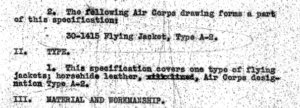
Drawing number 30-1415
The jacket was made by 15 manufacturers who shared about 40 contracts. Manufacturers were Aero Leather Clothing Co., Inc.; Rough Wear Clothing Co.; Werber Sportswear Co.; J.A. Dubow Mfg. Co.; Perry Sportswear Inc.; Monarch Mfg. Co.; Cooper Sportswear Mfg. Co.; Cable Raincoat Co.; Star Sportswear Mfg. Co.; Poughkeepsie Leather Coat Co.; I. Spiewak & Sons Co., Inc.; United Sheeplined Clothing Co.; Bronco Mfg. Corp.; David D. Doniger & Co. and Security Aviation Togs Co. Sizes ran from size 32 (482.000 were made) to size 54 (492.000 were made). On April 27, 1943, Type A-2 was declared Limited Standard, meaning that only replacements for in-service units could be ordered. New units would now be supplied with cloth-shelled jackets such as Types B-10 and B-15.
The jacket was made of waterproofed horsehide and vegetable-or chrome-tanned. Due to a shortage of horsehide later models were made of goatskin or steer-hide leather. The A-2 jacket has: a snap-flap patch pocket on either side that does not have hand warmer compartments (hands in pockets were considered unfit for a military bearing), a shirt-style snap-down collar, shoulder straps (or Epaulets), knit cuffs and waistband, a back constructed from a single piece of leather to limit stress on the garment, and a lightweight silk or cotton inner lining with a leather hang strap (not a loop), two ventilation eyelets under each arm and military spec tag attached just below the back collar. Many improvements were made to the jacket. One of those improvements were the shoulder straps to cope with the weight of the parachute harness.
The A-2 was one of the early articles of clothing designed expressly to use a zipper. Zippers were made of steel or brass, and some were nickel plated. Known zipper suppliers were Talon, Crown, Conmar, and Kwik, with Talon providing the majority of zippers used in wartime A-2 construction. Until about 1940, Talon zippers with riveted or grommeted metal bottoms were used.
The A-2 jacket was awarded after completion of basic flight training. First only exclusive to commissioned officers until early in World War II, when also issued to enlisted aircrews. Men would line up in front of boxes containing jackets and would be given the right size by the base quartermaster. The quartermaster would also do repair work on the jackets and re-dye them usually in a very dark colour.
Richard Gibbs, 749th Bomb Squadron, writes this about his A-2 jacket:
Upon arrival at the 749th Squadron in May 1944, we immediately noticed something different from anything we had experienced before…….the men wore all types of outfits. Most wore A2 jackets as the outer cover. These A2 jackets were painted with all kinds of things……bombs on the front of jacket, and pictures of a airplanes or perhaps a girl on the back. We immediately felt a little out of place with our shiny new A2 jackets that had just been issued in Kearney Nebraska a couple weeks before.
The A-2 jacket was a cool jacket to wear and made the men look like movie stars. Men decorated the jackets with group- and squadron patches, rank, name tag, wings etc. Most famous is the personalized art that was painted on the jackets. Sometimes nose art was painted on the back of the jacket of an individual or on all the jackets of a crew. Sometimes names of girlfriends were added and sometimes small bombs were added on the jacket the show how many missions had already been flown.
Men could decide what they wanted painted on their A-2 jackets and the base commanders didn’t interfere a lot. This all changed a little bit after one of the B17’s from the 351st Bomb Group was shot down on November 26, 1943 over Germany. This crew usually flew a B-17 named ‘Murder Inc’ but because of engine problems flew, on this mission, a B-17 named ‘Aristocrap’. The crew had ‘Muder Inc’ painted on the back of their A-2 jackets. Eventually lt. Kenneth Daniel Williams, bombardier, was used by the Germans as propaganda placing his photo wearing his ‘Muder Inc’ A-2 jacket in the newspapers. These were the murderous, American gangsters who enjoyed killing the Germans. This incident resulted in new rules ordering that every name of a B-17 in the 8th Air Force had to be approved. I am not sure if that really happened but could this be the reason that A/C 43 – 38540, ‘Murderous Witch’ was changed in ‘Mysterious Witch’?
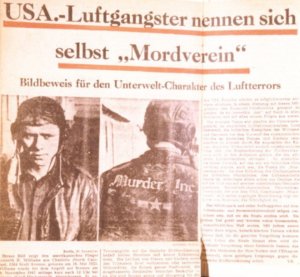
The German newspaper with the ‘Muder Inc’ article
In our group we had a wide range of decorations on jackets too. I am not sure what the numbers are but we see a lot of group- and squadron patches added on jackets. Some of the guys have painted their names on their jackets instead of using the more common leather name tag. I have been able to find a few A-2 jackets of our group with nose art on the back. There must have been a lot more but we have no knowledge of these or photos. Cpl. Lester Fried, Pfc. Edgar O’Donnell, Richard Rusling and Pvt. Calvin K. Hanks were some of the base artists doing the nose art on the planes and on the jackets. You can find some of Cpl. Lester Fried’s work here.
A/C 42 – 32101 was called ‘El Lobo II’. The crew had ‘El Lobo II’ painted on the back of their A-2 jackets. During the 1976 457th Bomb Group Association reunion Lt. Richard Fitzhugh (pilot) is seen wearing his (some info says it is the jacket of radio operator Sgt. Howard Larsen) A-2 jacket with the ‘El Lobo II’ art on the back of his jacket. The ‘El Lobo II’ nose art was seen again but this time painted on the nose of a B-52 from the 2nd Bomb Wing, Barksdale AFB, Louisiana.
Here you will find a collection of old A-2 jacket photos: 1944 – 1945
Here is a collection of surviving 457th Bomb Group A-2 jackets:


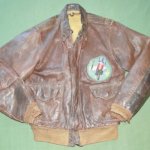
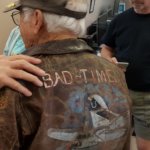
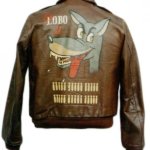
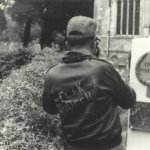
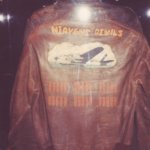
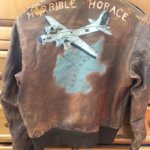
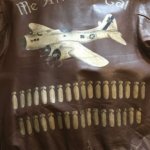
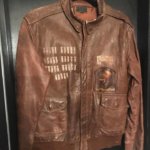
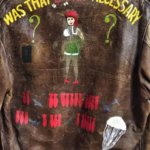

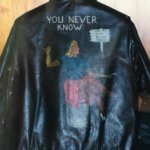
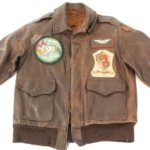
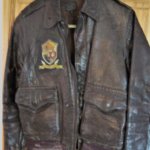
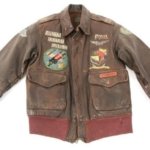
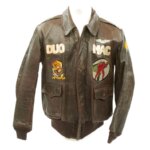


Fantastic article. I really enjoyed the info on the A-2 jackets!